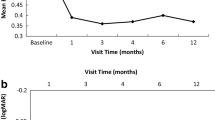Abstract.
Purpose: To determine the effect of a triamcinolone-assisted pars plana vitrectomy (PPV) on the visibility of hyaloid during surgery and the postoperative clinical outcome. Methods: Thirty-one patients with proliferative retinal disease [8 with diabetic macular edema (DME), 10 with proliferative diabetic retinopathy (PDR), 13 with proliferative vitreoretinopathy (PVR)] underwent PPV, where the vitreous body was visualized by the intravitreal injection of triamcinolone solution during the operation. The visual acuity, intraocular pressure (IOP), tamponade, corneal pathology, after-cataract, vitreous hemorrhage, and necessity of reoperation, were thereafter examined for at least 3 months after surgery. The anterior chamber laser flare cell meter was used on postoperative day 8 in DME eyes with triamcinolone-assisted PPV and with routine PPV to evaluate the breakdown of the blood–ocular barrier. Results: The vitreous body was clearly seen by means of triamcinolone during surgery, which greatly helped us to perform a posterior hyaloid resection safely and thoroughly. Six of 8 DME eyes, 8 of 10 PDR eyes, and 5 of 13 PVR eyes showed an improvement in their vision postoperatively. No eye except one experienced IOP elevation above 21 mmHg for 7 days. Six eyes had vitreous hemorrhage. The DME eyes which received triamcinolone-assisted PPV showed significantly less breakdown of the blood–ocular barrier than those with routine PPV (Mann–Whitney U-test, P<0.01). Conclusion: Triamcinolone improved the visibility of the hyaloid and the safety of the surgical procedures during PPV and also inhibited the postoperative breakdown of the blood–ocular barrier. Although the long-term effects are still unknown, this method appears potentially useful as an improved treatment for proliferative retinal diseases.
Similar content being viewed by others
Explore related subjects
Discover the latest articles and news from researchers in related subjects, suggested using machine learning.Author information
Authors and Affiliations
Additional information
Electronic Publication
Rights and permissions
About this article
Cite this article
Sakamoto, T., Miyazaki, M., Hisatomi, T. et al. Triamcinolone-assisted pars plana vitrectomy improves the surgical procedures and decreases the postoperative blood–ocular barrier breakdown. Graefe's Arch Clin Exp Ophthalmol 240, 423–429 (2002). https://doi.org/10.1007/s00417-002-0454-2
Received:
Revised:
Accepted:
Published:
Issue Date:
DOI: https://doi.org/10.1007/s00417-002-0454-2




